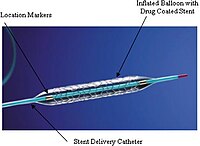
Photo from wikipedia
The aim of this study is to synthesize Titania nanotubes (TNTs) on the 3D-printed Ti-6Al-4V surface and investigate the loading of antibacterial vancomycin drug dose of 200 ppm for local… Click to show full abstract
The aim of this study is to synthesize Titania nanotubes (TNTs) on the 3D-printed Ti-6Al-4V surface and investigate the loading of antibacterial vancomycin drug dose of 200 ppm for local drug treatment application for 24 h. The antibacterial drug release from synthesized nanotubes evaluated via the chemical surface measurement and the linear fitting of Korsmeyer–Peppas model was also assessed. The TNTs were synthesized on the Ti-6Al-4V surface through the anodization process at different anodization time. The TNTs morphology was characterized using field emission scanning electron microscope (FESEM). The wettability and the chemical composition of the Ti-6Al-4V surface and the TNTs were assessed using the contact angle meter, Fourier transform infrared spectrophotometer (FTIR) and the X-ray photoelectron spectroscopy (XPS). The vancomycin of 200 ppm release behavior under controlled atmosphere was measured by the high-performance liquid chromatography (HPLC) and hence, the position for retention time at 2.5 min was ascertained. The FESEM analysis confirmed the formation of nanostructured TNTs with vertically oriented, closely packed, smooth and unperforated walls. The maximum cumulative vancomycin release of 34.7% (69.5 ppm) was recorded at 24 h. The wetting angle of both Ti-6Al-4V implant and the TNTs were found below 90 degrees. This confirmed their excellent wettability.
Journal Title: Materials
Year Published: 2021
Link to full text (if available)
Share on Social Media: Sign Up to like & get
recommendations!